高中英语简单句-五种基本句型课件(共24张PPT)
文档属性
| 名称 | 高中英语简单句-五种基本句型课件(共24张PPT) |
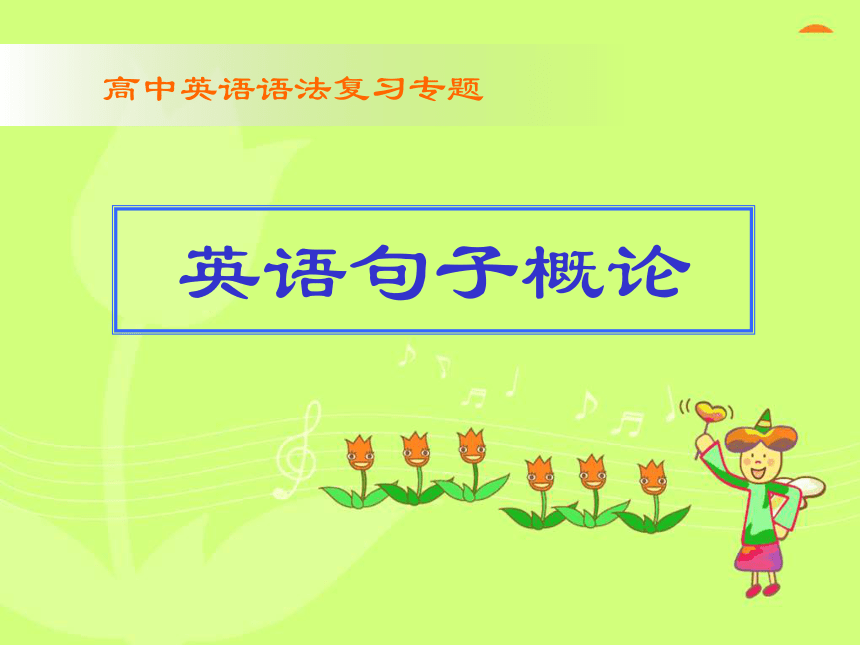
|
|
| 格式 | zip | ||
| 文件大小 | 587.8KB | ||
| 资源类型 | 教案 | ||
| 版本资源 | 通用版 | ||
| 科目 | 英语 | ||
| 更新时间 | 2019-02-18 17:53:06 | ||
图片预览

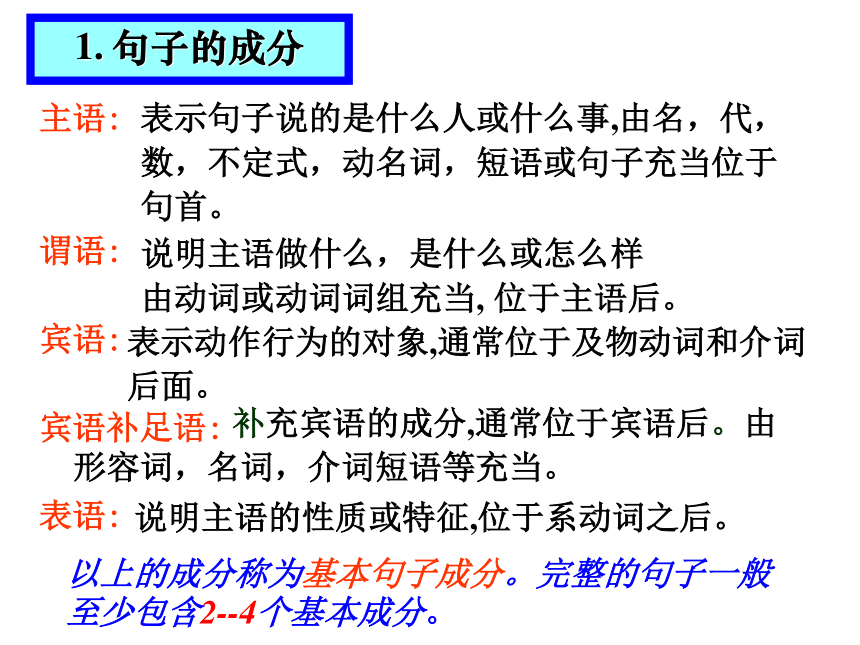
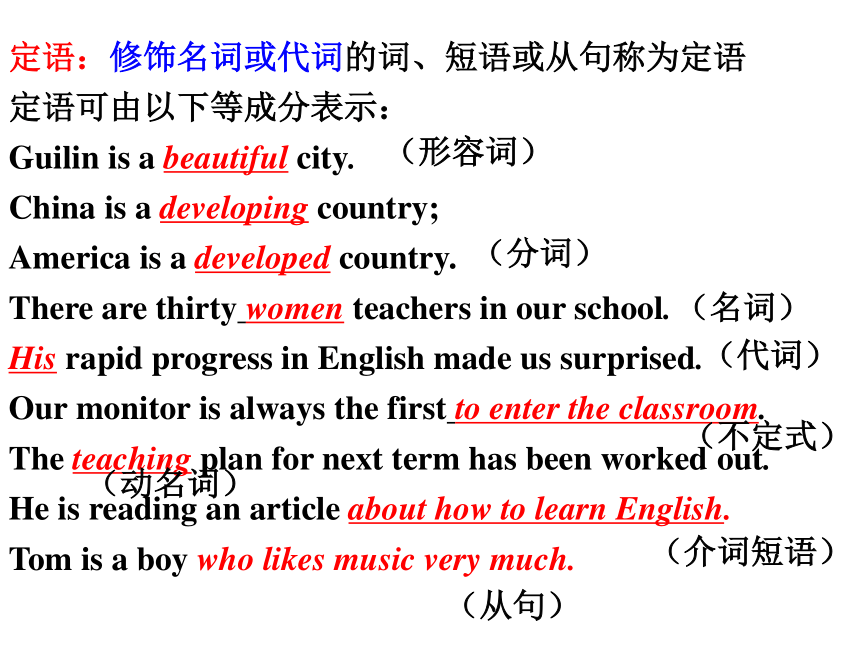


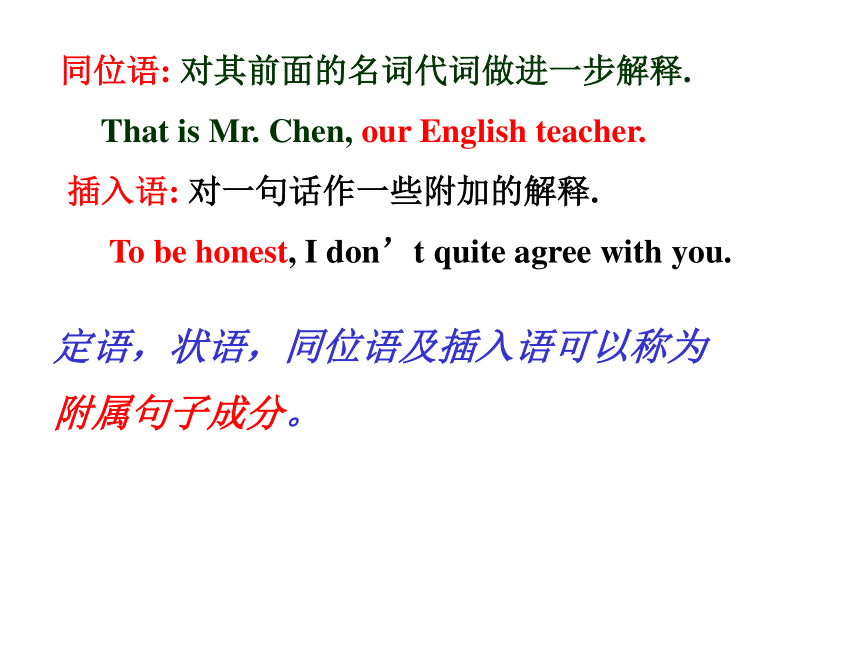
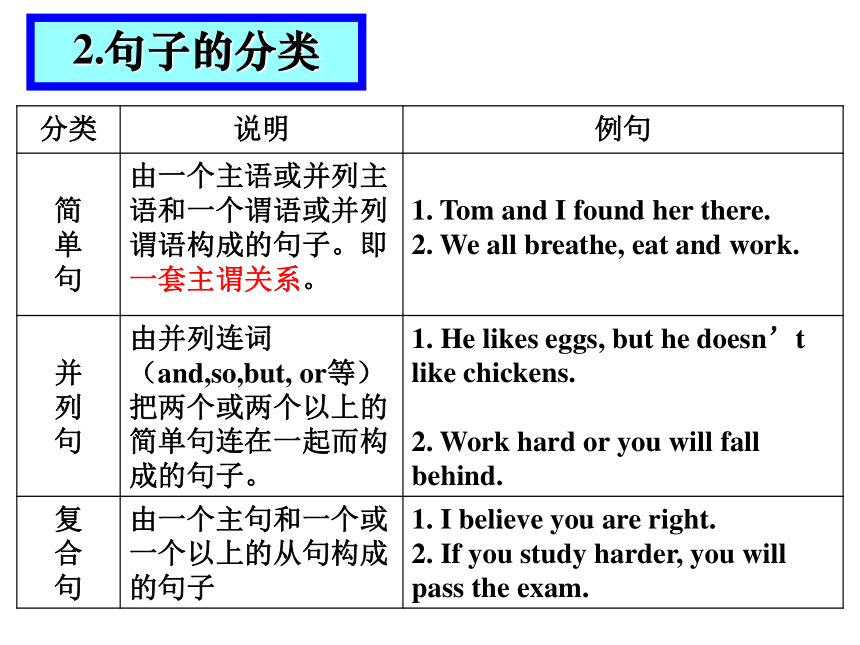
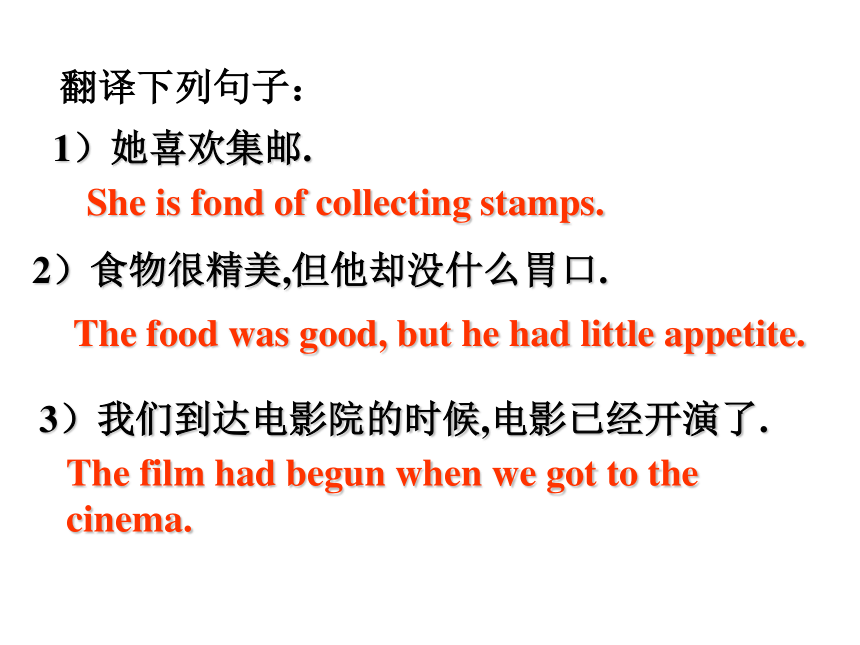

文档简介
课件24张PPT。英语句子概论1. 句子的成分主语:
谓语:
宾语:
宾语补足语:
表语:
表示句子说的是什么人或什么事,由名,代,数,不定式,动名词,短语或句子充当位于句首。说明主语做什么,是什么或怎么样
由动词或动词词组充当, 位于主语后。表示动作行为的对象,通常位于及物动词和介词后面。 补充宾语的成分,通常位于宾语后。由形容词,名词,介词短语等充当。说明主语的性质或特征,位于系动词之后。以上的成分称为基本句子成分。完整的句子一般至少包含2--4个基本成分。定语:修饰名词或代词的词、短语或从句称为定语
定语可由以下等成分表示:
Guilin is a beautiful city.
China is a developing country;
America is a developed country.
There are thirty women teachers in our school.
His rapid progress in English made us surprised.
Our monitor is always the first to enter the classroom.
The teaching plan for next term has been worked out.
He is reading an article about how to learn English.
Tom is a boy who likes music very much.
(形容词)(分词)(名词)(代词)(不定式)(动名词)(介词短语)(从句)状语:修饰动词、形容词、副词或整个句子,
说明动作或状态特征的句子成分,叫做状语。
通常有副词,介词短语和从句充当.
状语种类如下:
How about meeting again at six?
Last night she didn’t go to the dance party because of
the rain.
I shall go there if it doesn’t rain.
Mr Smith lives on the third floor.
(时间状语)(原因状语)(条件状语)(地点状语)She put the eggs into the basket with great care.
She came in with a dictionary in her hand.
In order to catch up with the others, I must work harder.
He was so tired that he fell asleep immediately.
She works very hard though she is old.
I am taller than he is. 方式状语伴随状语目的状语结果状语让步状语比较状语同位语: 对其前面的名词代词做进一步解释.
That is Mr. Chen, our English teacher.
插入语: 对一句话作一些附加的解释.
To be honest, I don’t quite agree with you.定语,状语,同位语及插入语可以称为
附属句子成分。2.句子的分类1)她喜欢集邮.
2)食物很精美,但他却没什么胃口.
3)我们到达电影院的时候,电影已经开演了.
She is fond of collecting stamps.The food was good, but he had little appetite.The film had begun when we got to the cinema. 翻译下列句子: 判断下列句子是简单句、并列句还是复合句:
1. We often study Chinese history on Friday afternoon.
2. The boy who offered me his seat is called Tom.
3. There is a chair in this room.
4. My brother and I go to school at half past seven in the morning and come back home at seven in the evening.简单句 复合句 简单句 简单句 5. He is in Class One and I am in Class Two.
6. He was fond of drawing when he was yet a child.
7. Neither has he changed his mind, nor will he do so.
8. What he said at the meeting is very important.
9. The farmer is showing the boy how to plant a tree.
10. Both Tom and Jack enjoy country music.并列句 复合句 并列句 复合句 简单句 简单句 3. 简单句基本句型英语五种基本句型列式如下:
基本句型一: S +V (主+谓)
基本句型二: S +V +P (主+系+表)
基本句型三: S +V +O (主+谓+宾)
基本句型四: S +V +O1 +O2(主+谓+间宾
+直宾)
基本句型五: S +V +O +C(主+谓+宾+宾补)基本句型 一
S + V(主+谓)此句型中动词是不及物动词,能表达完整意思。
主语可有修饰语---定语,谓语可有修饰语---状语,
如,The red sun rises in the east.基本句型 二
S + V + P(主+系+表)此句型中谓语动词都不能表达一个完整的意思,必须加上一个表明主语身份或状态的表语构成复合谓语,才能表达完整的意思。
系动词有三类:
1.表示特征和存在状态的: be, seem, appear, feel ,look,
smell, sound, taste
2. 表状态延续的:remain, stay, keep, continue, stand
3. 表状态变化 的:become, get, turn, go, run, fall, come,
grow 基本句型 三
S +V +O(主+谓+宾)此句型中的谓语动词是及物动词,必须跟一个宾语,才能使意思完整,而宾语成分的多样化使这一结构异常复杂。 基本句型 四
S +V +IO +O(主+谓+间宾+直宾)此句型中的谓语动词必须有两个宾语才能表达完整的意思。这两个宾语一个是动作的直接承受者(多指物),另一个是动作的间接宾语(多指人)。
若要先说出直接宾语,后说间接宾语,则要借助与介词to 或for。
He bought me a beautiful skirt.
He bought a beautiful skirt for me.用to侧重指动作的方向,表示朝着,向着,对着某人。
用for 侧重指动作的受益者,表示为了某人,替某人。
常跟双宾语的动词有:
(需借助 to的)bring, give, lend, hand, offer, pass, pay,
promise, return, send, show, teach, tell, write, ask等
(需借助for的)buy, call, cook, choose, draw, find, get,
make, order, sing等。 基本句型 五
S +V +O +C(主+谓+宾+宾补)此句型中谓语动词除了跟一个宾语外,还需跟一个补充成分来不足宾语,才能使意思完整。注意:用 it 做形式宾语,而将真正的宾语放到
宾语补足语的后面,是英语常用句型。即 主语 + 谓语 + it + 宾补 + 真正宾语。如,
I found it very pleasant to be with your family.常用于此句型的动词有:think, believe, consider, suppose, find, feel, make使用it当形式宾语翻译下面的句子
1.他感到很难跟你交谈。
2.我认为有可能用另一种方法解题。
3.学校定了一条规则,开始上课时学生要起立。
4. 我认为与那个人谈话是无益的。 1.He felt it very difficult to talk with you.
2.I consider it possible to work out the problem in
another way.
3.The school made it a rule that the students should
stand up when class begins.
4.I thought it no use talking with that manYou are sitting on the train home.
There comes the bus !
The ego’s potential for expansion is limitless.
Breckenridge hosts the international Snow Sculpture Championships.
Our neighbors gave us a baby bird yesterday.
We think it our duty to study well.主+谓(S+V)主+谓(S+V)主+系 +表(S+V+P)主+谓 +宾(SVO)主+谓 +间宾 +直宾(SVOiOd)主+谓 +宾 +补(SVOC)判断下列句子属于何种句式.Exercises :更正下列句子的错误Exercises :1. He came the room.
2. The music sounds.
3. I have seen.
4. He gave a pen me.
5. The boss made the boy to work hard.
6. My father bought a book to me. 1. He came into the room.
2. The music sounds wonderful.
3. I have seen the film.
4. He gave a pen to me.
5. The boss made the boy work hard.
6. My father bought a book for me . Exercises : 翻译下列句子并分析句子结构:1.我经常在早晨读英语。 2.玛丽是个聪明的学生。
3.我的老师交给我一封信。4.我母亲经常叫我努力学习。
5.我们叫我们的老师王先生 6.他正在房里做家庭作业。1. I often read English in the morning. 2. Mary is a clever student. 3. My teacher gave me a letter. 4. My mother often asks me to study hard. 5. We call our teacher Mr. Wang. 6. He is doing his homework in the room. 主 + 谓 + 宾主 + 系 + 表 主 + 谓 + 双宾 主+ 谓 + 宾 +宾补主+ 谓 + 宾 + 宾补主 + 谓 + 宾英语句子的基本结构可以归纳成五种基本句型及其扩大、组合、省略或倒装。
掌握这五种基本句型,是掌握各种英语句子结构的基础。
Homework:
谓语:
宾语:
宾语补足语:
表语:
表示句子说的是什么人或什么事,由名,代,数,不定式,动名词,短语或句子充当位于句首。说明主语做什么,是什么或怎么样
由动词或动词词组充当, 位于主语后。表示动作行为的对象,通常位于及物动词和介词后面。 补充宾语的成分,通常位于宾语后。由形容词,名词,介词短语等充当。说明主语的性质或特征,位于系动词之后。以上的成分称为基本句子成分。完整的句子一般至少包含2--4个基本成分。定语:修饰名词或代词的词、短语或从句称为定语
定语可由以下等成分表示:
Guilin is a beautiful city.
China is a developing country;
America is a developed country.
There are thirty women teachers in our school.
His rapid progress in English made us surprised.
Our monitor is always the first to enter the classroom.
The teaching plan for next term has been worked out.
He is reading an article about how to learn English.
Tom is a boy who likes music very much.
(形容词)(分词)(名词)(代词)(不定式)(动名词)(介词短语)(从句)状语:修饰动词、形容词、副词或整个句子,
说明动作或状态特征的句子成分,叫做状语。
通常有副词,介词短语和从句充当.
状语种类如下:
How about meeting again at six?
Last night she didn’t go to the dance party because of
the rain.
I shall go there if it doesn’t rain.
Mr Smith lives on the third floor.
(时间状语)(原因状语)(条件状语)(地点状语)She put the eggs into the basket with great care.
She came in with a dictionary in her hand.
In order to catch up with the others, I must work harder.
He was so tired that he fell asleep immediately.
She works very hard though she is old.
I am taller than he is. 方式状语伴随状语目的状语结果状语让步状语比较状语同位语: 对其前面的名词代词做进一步解释.
That is Mr. Chen, our English teacher.
插入语: 对一句话作一些附加的解释.
To be honest, I don’t quite agree with you.定语,状语,同位语及插入语可以称为
附属句子成分。2.句子的分类1)她喜欢集邮.
2)食物很精美,但他却没什么胃口.
3)我们到达电影院的时候,电影已经开演了.
She is fond of collecting stamps.The food was good, but he had little appetite.The film had begun when we got to the cinema. 翻译下列句子: 判断下列句子是简单句、并列句还是复合句:
1. We often study Chinese history on Friday afternoon.
2. The boy who offered me his seat is called Tom.
3. There is a chair in this room.
4. My brother and I go to school at half past seven in the morning and come back home at seven in the evening.简单句 复合句 简单句 简单句 5. He is in Class One and I am in Class Two.
6. He was fond of drawing when he was yet a child.
7. Neither has he changed his mind, nor will he do so.
8. What he said at the meeting is very important.
9. The farmer is showing the boy how to plant a tree.
10. Both Tom and Jack enjoy country music.并列句 复合句 并列句 复合句 简单句 简单句 3. 简单句基本句型英语五种基本句型列式如下:
基本句型一: S +V (主+谓)
基本句型二: S +V +P (主+系+表)
基本句型三: S +V +O (主+谓+宾)
基本句型四: S +V +O1 +O2(主+谓+间宾
+直宾)
基本句型五: S +V +O +C(主+谓+宾+宾补)基本句型 一
S + V(主+谓)此句型中动词是不及物动词,能表达完整意思。
主语可有修饰语---定语,谓语可有修饰语---状语,
如,The red sun rises in the east.基本句型 二
S + V + P(主+系+表)此句型中谓语动词都不能表达一个完整的意思,必须加上一个表明主语身份或状态的表语构成复合谓语,才能表达完整的意思。
系动词有三类:
1.表示特征和存在状态的: be, seem, appear, feel ,look,
smell, sound, taste
2. 表状态延续的:remain, stay, keep, continue, stand
3. 表状态变化 的:become, get, turn, go, run, fall, come,
grow 基本句型 三
S +V +O(主+谓+宾)此句型中的谓语动词是及物动词,必须跟一个宾语,才能使意思完整,而宾语成分的多样化使这一结构异常复杂。 基本句型 四
S +V +IO +O(主+谓+间宾+直宾)此句型中的谓语动词必须有两个宾语才能表达完整的意思。这两个宾语一个是动作的直接承受者(多指物),另一个是动作的间接宾语(多指人)。
若要先说出直接宾语,后说间接宾语,则要借助与介词to 或for。
He bought me a beautiful skirt.
He bought a beautiful skirt for me.用to侧重指动作的方向,表示朝着,向着,对着某人。
用for 侧重指动作的受益者,表示为了某人,替某人。
常跟双宾语的动词有:
(需借助 to的)bring, give, lend, hand, offer, pass, pay,
promise, return, send, show, teach, tell, write, ask等
(需借助for的)buy, call, cook, choose, draw, find, get,
make, order, sing等。 基本句型 五
S +V +O +C(主+谓+宾+宾补)此句型中谓语动词除了跟一个宾语外,还需跟一个补充成分来不足宾语,才能使意思完整。注意:用 it 做形式宾语,而将真正的宾语放到
宾语补足语的后面,是英语常用句型。即 主语 + 谓语 + it + 宾补 + 真正宾语。如,
I found it very pleasant to be with your family.常用于此句型的动词有:think, believe, consider, suppose, find, feel, make使用it当形式宾语翻译下面的句子
1.他感到很难跟你交谈。
2.我认为有可能用另一种方法解题。
3.学校定了一条规则,开始上课时学生要起立。
4. 我认为与那个人谈话是无益的。 1.He felt it very difficult to talk with you.
2.I consider it possible to work out the problem in
another way.
3.The school made it a rule that the students should
stand up when class begins.
4.I thought it no use talking with that manYou are sitting on the train home.
There comes the bus !
The ego’s potential for expansion is limitless.
Breckenridge hosts the international Snow Sculpture Championships.
Our neighbors gave us a baby bird yesterday.
We think it our duty to study well.主+谓(S+V)主+谓(S+V)主+系 +表(S+V+P)主+谓 +宾(SVO)主+谓 +间宾 +直宾(SVOiOd)主+谓 +宾 +补(SVOC)判断下列句子属于何种句式.Exercises :更正下列句子的错误Exercises :1. He came the room.
2. The music sounds.
3. I have seen.
4. He gave a pen me.
5. The boss made the boy to work hard.
6. My father bought a book to me. 1. He came into the room.
2. The music sounds wonderful.
3. I have seen the film.
4. He gave a pen to me.
5. The boss made the boy work hard.
6. My father bought a book for me . Exercises : 翻译下列句子并分析句子结构:1.我经常在早晨读英语。 2.玛丽是个聪明的学生。
3.我的老师交给我一封信。4.我母亲经常叫我努力学习。
5.我们叫我们的老师王先生 6.他正在房里做家庭作业。1. I often read English in the morning. 2. Mary is a clever student. 3. My teacher gave me a letter. 4. My mother often asks me to study hard. 5. We call our teacher Mr. Wang. 6. He is doing his homework in the room. 主 + 谓 + 宾主 + 系 + 表 主 + 谓 + 双宾 主+ 谓 + 宾 +宾补主+ 谓 + 宾 + 宾补主 + 谓 + 宾英语句子的基本结构可以归纳成五种基本句型及其扩大、组合、省略或倒装。
掌握这五种基本句型,是掌握各种英语句子结构的基础。
Homework:
